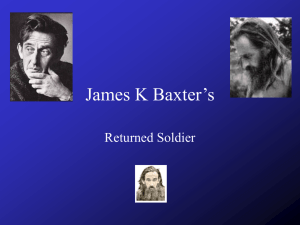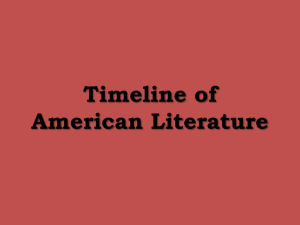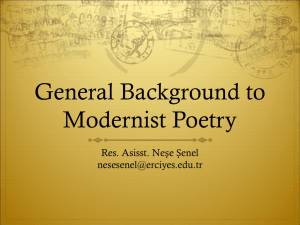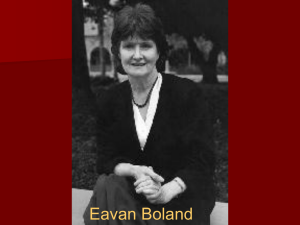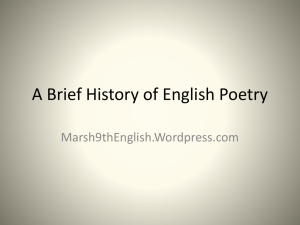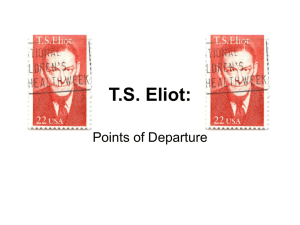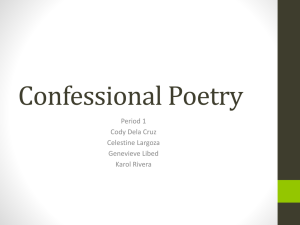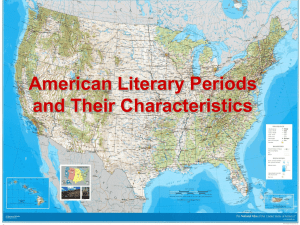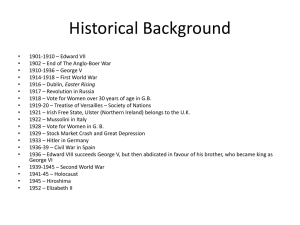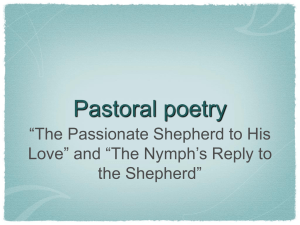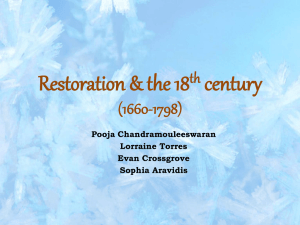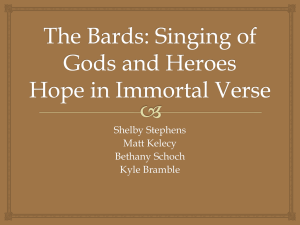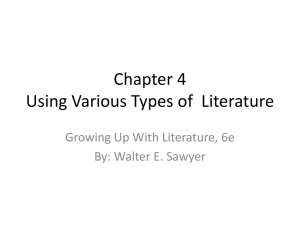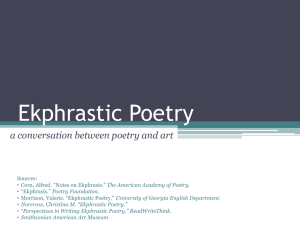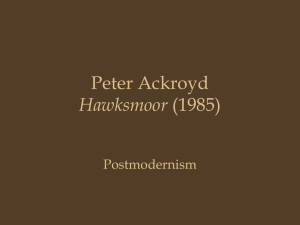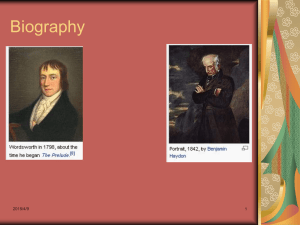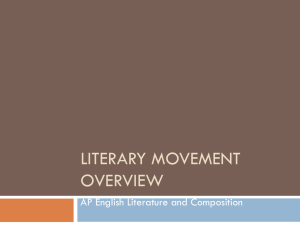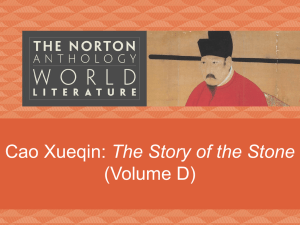The History of World Literature 1000 BC
advertisement
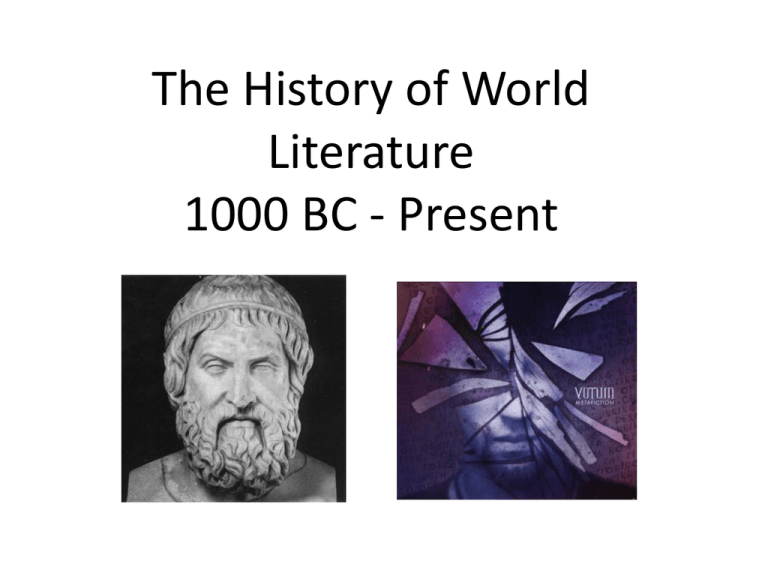
The History of World Literature 1000 BC - Present 800BC-400BC: Ancient Greek Literature • Forms the basis of liberal arts education, and has been taught since organized education began. Includes philosophical treatises, epic poetry, myths and plays. • Aristotle, Poetics • Plato, The Apology • Sophocles, Antigone • Homer, The Illiad & The Odyssey 450-1066: Anglo-Saxon (Old English) Literature • Primarily consists of poems already circulating in oral form at the time they were first written down. The bulk of the prose literature is historical or religious in nature. • Beowulf • The transitional period between Anglo-Saxon and modern English literature. This time period saw a flowering of secular literature, including ballads and allegorical poems. • Petrarch Petrarchan sonnets • Dante Aligheri The Divine Comedy • Geoffrey Chaucer The Canterbury Tales 1500-1660: The Renaissance • Influenced by the artistic and cultural Renaissance, the transformation of both English language and literature in this period can be seen to move away from the medieval Middle English literature period and into the more recognizably modern Elizabethan literature. • The period is characterized by the influence of the classics (in literature, language, and philosophy), as well as an optimistic forwardthinking approach to the potential of humans. The Renaissance (cont’d) • Miguel Cervantes Don Quixote, • William Shakespeare plays & sonnets • Christopher MarloweDr. Faustus, pastoral poetry • Ben Jonson: satirical plays & lyric poetry • John Donne: metaphysical poetry • Edmund Spenser The Faerie Queen • John Milton Paradise Lost • A movement whose artists looked to the classical texts for their creative inspiration in an effort to imitate classical form. The writers in particular drew on what were considered to be classical virtues—simplicity, order, restraint, logic, economy, accuracy, and decorum—to produce prose, poetry, and drama. Literature was of value in accordance with its ability to not only delight, but also instruct. • Voltaire Candide • Alexander Pope epic and narrative poetry, heroic couplet • Daniel Defoe Robinson Crusoe • Jonathan Swift Gulliver’s Travels • In Puritan literature, the writers' purpose is to show how God works in their lives. Plain style writing avoids irony, humor, hyperbole, and any literary device that might keep the reader from understanding the writer's purpose. • Anne Bradstreet To My Dear and Loving Husband • Edward Taylor Huswifery • Jonathan Edwards Sinners in the Hands of an Angry God • The 18th-century American “Age of Reason” was a movement marked by an emphasis on rationality rather than religious tradition. It’s foremost thinkers, Benjamin Franklin and Thomas Jefferson, also served as political leaders of the American Revolution. Some of the most noteworthy characteristics of this movement were: • constructive deism — the belief that Reason leads us to some basic religious truths and that morality is an intellectual pursuit rather than a religious one. • scientific inquiry instead of unquestioning religious dogma • representative government in place of monarchy. • emphasis on ideals of justice, liberty, and equality as the natural rights of man • intellectual pursuit is the highest form of human consciousness. Faith in human goodness and dignity of humankind. • Romanticism was an artistic and intellectual movement that originated in late 18th century Western Europe and quickly spread to America. Some of the main underlying ideas of the movement are: • The idea that neither theism nor deism can adequately answer the question of man’s relationship with God. • The belief in the natural goodness of man and the idea that man, in a state of nature, would behave well but is hindered by civilization. • A revolt against aristocratic, social, and political norms of the Enlightenment period and a reaction against the rationalization of nature, in art and literature. • Influenced by ideas of the Enlightenment, particularly that the past is the key to the present. • Romantic artists wished to move away from the formality of the previous generation. Strong emotion became a source of aesthetic experience, placing new emphasis on such emotions as trepidation, horror, and the awe experienced in confronting the sublimity of nature. Romanticism (cont’d) British Poetry • William Blake • William Wordsworth • Samuel Taylor Coleridge • Lord Byron • Percy Bysshe Shelley • John Keats • Alfred Lord Tennyson British Literature • Jane Austen • Mary Shelley Pride and Prejudice Frankenstein American Literature • Washington Irving Rip Van Winkle • James Fenimore Cooper Last of the Mohicans • Victorian novels tend to be idealized portraits of difficult lives in which hard work, perseverance, love and luck win out in the end; virtue would be rewarded and wrongdoers are suitably punished. They often contain a central moral lesson or theme. Victorian Period (cont’d) World Literature • Henrik Ibsen • Victor Hugo • Gustave Flaubet A Doll’s House Les Miserables Madame Bovary British Victorian Poetry • Robert Browning • Elizabeth Barrett Browning British Victorian Literature • Charlotte Bronte Jane Eyre • Emily Bronte Wuthering Heights • Charles Dickens Great Expectations • A period during which American literature came of age as an expression of a national spirit. These authors utilized native dialect, history, landscape, and characters in order to explore uniquely American issues. Critics regard some of the short fiction produced during the American Renaissance as some of the best American fiction ever written. • Emily Dickinson poetry • Walt Whitman poetry • Herman Melville Moby Dick & Billy Budd • Nathaniel Hawthorne The Scarlet Letter 1835-1860: Transcendentalism • The American Renaissance was closely associated with an intellectual movement known as Transcendentalism, a philosophy or system of thought based on the idea that humans are essentially good, that humanity's deepest truths may be formulated through insight rather than logic, and that there is an essential unity to all of creation. • Ralph Waldo Emerson Nature & Self Reliance • Henry David Thoreau Walden & Civil Disobedience • 1855-1900: American Realism & Regionalism • • • • • • • • • • A literary movement that attempted to portray an accurate, detailed picture of ordinary, contemporary life. Some of its main ideas were: Character is more important than action and plot: complex ethical choices are often the subject. Humans control their destinies: characters act on their environment rather than simply reacting to it. Renders reality closely and in comprehensive detail: Selective presentation of reality with an emphasis on verisimilitude, even at the expense of a well-made plot. Events will usually be plausible: Realistic novels avoid the sensational, dramatic elements of the Romantic movement. Class is important: primarily, the interests and aspirations of an insurgent middle class. Diction is the natural vernacular: not heightened or poetic; tone may be comic, satiric, or matter-of-fact. The use of symbolism is controlled and limited: the realists depend more on the use of images. Mark Twain Kate Chopin The Adventures of Huckleberry Finn The Awakening 1890-1910: Naturalism (United States) • Naturalism describes a type of literature that attempts to apply scientific principles of objectivity and detachment to its study of human beings. It focuses on the "brute within" each individual, comprised of strong and often warring emotions: passions such as lust and greed, the desire for dominance or pleasure, and the fight for survival in an amoral, indifferent universe. Naturalist authors viewed nature as an indifferent force acting on the lives of human beings. • Jack London The Call of the Wild • Theodore Dreiser Sister Carrie • Edith Wharton Ethan Frome 1900-1940: Modernism • Modernism provided a radical break with traditional modes of literature. Its main characteristics were stylistic innovations disruption of traditional syntax and form – and an obsession with primitive attitudes (violence, self-centeredness) 1918-1940: The Lost Generation • A term used to describe the generation of writers, many of them soldiers, who published in the years following WW I. These authors were said to be disillusioned by the large number of casualties of the First World War, cynical, disdainful of the antiquated notions of morality and propriety of their elders and ambivalent about gender ideals. • F. Scott Fitzgerald The Great Gatsby • Ernest Hemingway The Sun Also Rises 1918-1930: The Harlem Renaissance • An explosion of African-American literature, art and music during the 1920’s. The artists of the Harlem Renaissance represented the first generation of African-Americans to receive a formal education, and their ascendance was predicted by author W.E.B. DuBois’ The Souls of Black Folk: "One ever feels his twoness - an American, a Negro; two souls, two thoughts, two unreconciled stirrings: two warring ideals in one dark body, whose dogged strength alone keeps it from being torn asunder." • Langston Hughes poet • Claude McKay poet • Zora Neale Hurston Their Eyes Were Watching God 1945-Present: Postmodernism • Because the postmodernism movement continues to this day, the period’s definition is constantly changing. • Unlike Modernism, Postmodernism has no crisis of belief in traditional authority. Modernist “angst” has been replaced with an "anything and everything goes" attitude. • Instead of seeking larger truths that appeal to a wide audience, literature seeks little truths that hopefully mean something to a portion of its readers. • Postmodernist literature doesn't believe there's a “real real” to represent –everything is a perspective. • Experimentation with form is no longer considered radical, as in modernism. Rather, experimentation with conventional forms is the norm--the convention--in postmodernism. Postmodernist authors aggressively attempt to mix of forms, genres, disciplines, and systems all within one work. Postmodernism (cont’d) Some of the main ideas of the Postmodern movement are: • Inaugurated by the Bomb Psychological effects of Post-Hiroshima America The Nuclear Age • New Forms of War Wars over political ideology (Korea, Vietnam) Transition from world wars to cold wars & civil wars Conceptual wars: Drugs, terrorism • The rise of multinationalism & capitalism Global village Global economy • Multiculturalism Minorities Women Confessional Poetry • Decline of industry & rise of the Information Age Internet/Video Games Technoculture & Hyperreality 1948-1960: The Beat Generation • The Beat Generation is a term used to describe both a group of American writers who came to prominence in the late 1950s and early 1960s and the cultural phenomena that they wrote about and inspired (later sometimes called "beatniks”). Beat Generation literature highlighted the core values of the movement: spontaneity, open emotion, visceral engagement in gritty worldly experiences. • Allen Ginsberg Howl (1956) • William S. Burroughs Naked Lunch (1959) 1958-1965: Confessional Poetry • Confessional poetry is defined as “the poetry of the personal”. The confessional poetry of the mid-twentieth century dealt with subject matter that previously had not been openly discussed in American poetry. Private experiences with and feelings about death, trauma, depression and relationships were addressed in this type of poetry, often in an autobiographical manner. • Robert Lowell Skunk Hour, Father’s Bedroom • Sylvia Plath The Bell Jar 1930s-Present: Magic Realism • Magic realism is a type of fiction in which magical elements are blended into a realistic atmosphere in order to access a deeper understanding of reality. These magical elements are explained like normal occurrences that are presented in a straightforward manner which allows the "real" and the "fantastic" to be accepted in the same stream of thought. • Gabriel Garcia Marquez Love in the Time of Cholera • Laura Esquivel Like Water for 1950s-Present: Postcolonial Literature • Literature by and about authors from former European colonies, primarily from Africa, Asia, South America and the Carribean. This literature aims to challenge Eurocentric assumptions through intense examination of culture and identity. • Chinua Achebe Things Fall Apart • Salman Rushdie Midnight’s Children 1960’s-Present: Metafiction • Metafiction is a type of fiction that selfconsciously addresses the devices of fiction, constantly reminding the reader that he or she is reading a fictional work. Some examples of metafiction are: • A novel about a person writing a novel • A novel about a person reading a novel • A novel in which the author is a character • Characters who express awareness that they are in a work of fiction. (also known as breaking the fourth wall.) • A work of fiction within a fiction. • Thomas Pynchon The Crying of Lot 49
